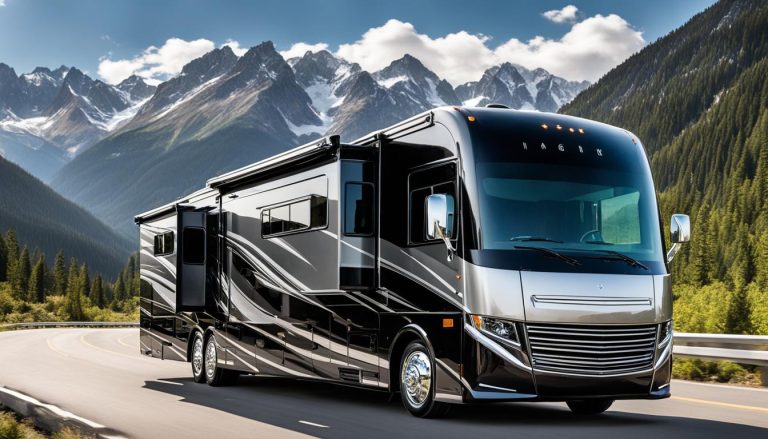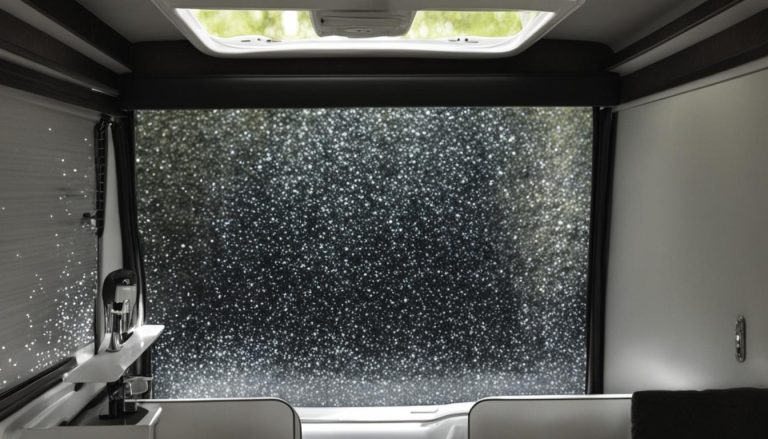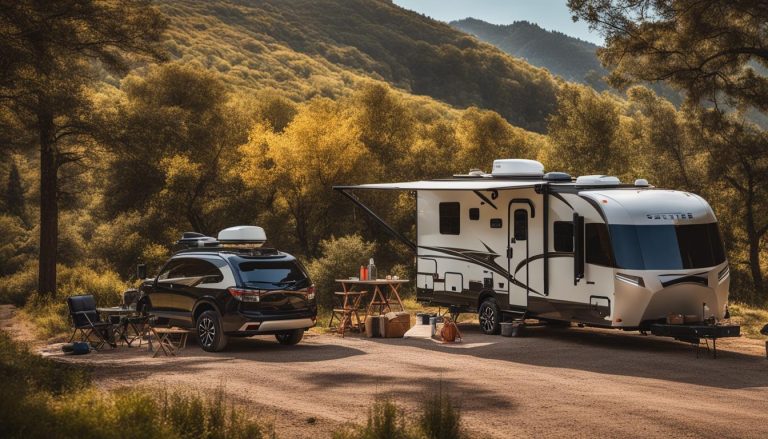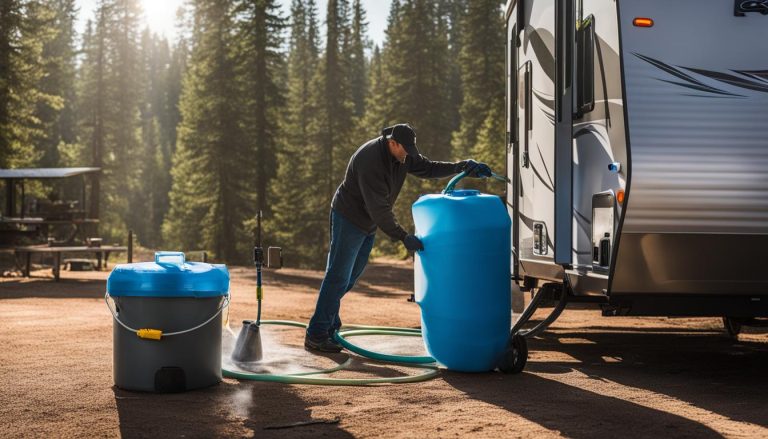Know When to Replace RV Tires for Safety
gorvlifestyle.com and its partners may earn a commission if you purchase a product through one of our links
The lifespan of RV tires is an important consideration for the safety and reliability of your recreational vehicle. Knowing when to replace your RV tires can prevent potential breakdowns on the road. Signs of worn RV tires include excessive wear, damage such as cuts or bulges, and dry rot. Regular inspections and maintenance are necessary to ensure the longevity of your tires and avoid dangerous situations.
Key Takeaways:
- Regularly inspect your RV tires for signs of wear, damage, or dry rot.
- Excessive wear, cuts, bulges, and dry rot are indicators that your RV tires need to be replaced.
- Perform routine maintenance to prolong the lifespan of your RV tires.
- Replace all tires at the same time for optimal performance and safety.
- Invest in high-quality tires suitable for your RV and travel needs.
How to Determine the Age of Your RV Tires
RV tires are an essential component of your recreational vehicle, ensuring a smooth and safe journey. However, like all tires, they have a limited lifespan. It’s crucial to determine the age of your RV tires to ensure they are in optimal condition and replace them at the proper time.
To determine the age of your RV tires, you can check the DOT number stamped on the sidewall. The DOT number contains valuable information, including the date of manufacture. This date is represented by a four-digit code, with the first two digits indicating the week and the last two digits representing the year of manufacture.
For example, if the DOT number on your tire reads “4219,” it means that the tire was manufactured in the 42nd week of the year 2019. By comparing this information with the current year, you can easily calculate the age of your tires.
It’s important to note that RV tires generally have a lifespan ranging from 3 to 5 years. However, factors such as usage, storage conditions, and maintenance practices can influence their longevity. Even if the tires appear to be in good condition, it’s essential to consider their age.
Over time, the rubber used in tires can deteriorate, becoming dry and brittle. This can significantly increase the risk of tire failure, leading to potentially dangerous situations on the road. Therefore, replacing your RV tires at the proper time is crucial for your safety and the performance of your recreational vehicle.
Tire Lifespan and Replacement Frequency Recommendations
The lifespan of an RV tire can vary depending on several factors, including the type of tire, usage patterns, and maintenance practices. While the general guideline for replacement is 3 to 5 years, it’s essential to consult the tire manufacturer’s recommendations for specific models and brands.
Note: The following information is provided as a general guideline. Always refer to the manufacturer’s specifications and consult with a professional for accurate recommendations based on your specific tire model.
| Type of RV Tire | Recommended Replacement Frequency |
|---|---|
| All-Season RV Tires | Every 3-5 years or between 20,000-40,000 miles |
| Summer/Performance RV Tires | Every 3-5 years or between 20,000-40,000 miles |
| Winter/Snow RV Tires | Every 3-5 years or between 20,000-40,000 miles |
Regularly inspecting your RV tires for signs of wear, damage, or dry rot is crucial, regardless of their age. These signs can indicate the need for immediate replacement, even if the tires haven’t reached their recommended lifespan.
Tip: Perform a visual inspection of your tires regularly and look for signs of uneven wear, bulges, cuts, or punctures. Additionally, pay attention to any loss of tread depth or cracking in the sidewalls. If you notice any of these signs, it’s essential to replace your RV tires promptly.
Proper tire maintenance, including regular inspections, proper inflation, and tire rotations, can help extend the lifespan of your RV tires. Following recommended maintenance practices and replacing your tires at the appropriate time will ensure that you enjoy a safe and comfortable journey in your recreational vehicle.
Signs of Worn RV Tires and When to Replace Them
When it comes to the safety of your RV, monitoring the condition of your tires is crucial. There are several indicators of rv tire wear that you should be aware of, as they can signal the need for replacement.
1. Uneven Tread Wear
One of the most common signs of worn RV tires is uneven tread wear. Inspect your tires regularly for any significant differences in tread depth across the tire’s surface. Uneven wear can indicate alignment issues or suspension problems, which need to be addressed promptly to prevent further damage to your tires.
2. Cracks in the Sidewall
Cracks in the sidewall of your RV tires are another red flag that they need to be replaced. These cracks often occur due to sun exposure, age, or improper storage. If you notice any cracks during your tire inspection, it’s best to replace the tires to avoid the risk of a blowout while on the road.
3. Punctures That Cannot Be Repaired
If your RV tires have sustained punctures or cuts that cannot be repaired, it’s crucial to replace them. While minor punctures can sometimes be patched, severe damage or multiple punctures may compromise the tire’s structural integrity, making it unsafe for use.
4. Loss of Tread Depth
Loss of tread depth is a clear indication that your RV tires need to be replaced. Tread depth is essential for providing grip and traction on the road, especially in wet or slippery conditions. If the tread is worn down to the wear bars or is significantly shallow, it’s time to invest in new tires for your RV.
Remember, even if your tires do not show any visible signs of wear or damage, it’s important to consider their age and maintenance history. RV tires generally have a lifespan of 3 to 5 years, depending on usage and storage conditions. If your tires are beyond the recommended lifespan, it’s advisable to replace them to ensure your safety on the road.
Regular tire inspections and maintenance are key to identifying signs of wear and addressing them promptly. By staying proactive and replacing worn RV tires when necessary, you can enjoy safer travels and peace of mind on your RV adventures.
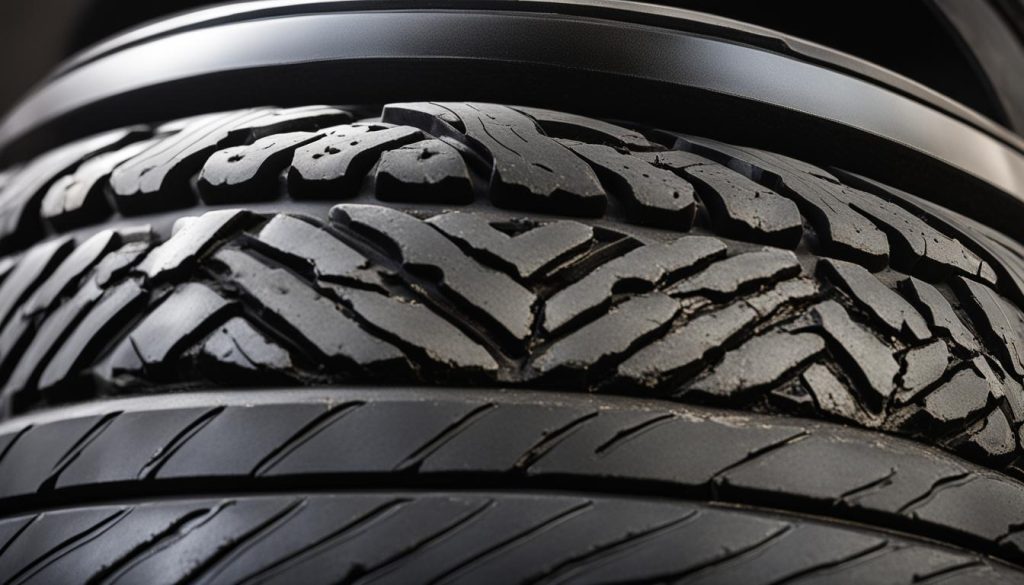
| Signs of Worn RV Tires | Indicators |
|---|---|
| Uneven tread wear | Tread depth varies significantly across the tire surface |
| Cracks in the sidewall | Visible cracks or splits in the sidewall of the tire |
| Punctures that cannot be repaired | Severe damage or multiple punctures that compromise tire integrity |
| Loss of tread depth | Tread worn down to the wear bars or significantly shallow |
Best Practices for RV Tire Replacement
When it comes to ensuring the safety and performance of your RV, proper tire replacement is essential. Follow these best practices for RV tire replacement to keep your travels smooth and worry-free.
- Replace all tires at the same time: To maintain optimal performance and safety, it’s recommended to replace all of your RV tires at the same time. This ensures balanced wear and consistent performance on the road.
- Choose high-quality tires: Invest in high-quality tires that are specifically designed for RV use and suitable for your particular RV and travel needs. Look for reputable brands known for their durability and performance.
- Maintain proper tire care: Regular tire maintenance is crucial for extending the lifespan of your new tires. Make it a habit to inspect your tires regularly for any signs of wear or damage. Check tire pressure regularly and ensure it is at the manufacturer’s recommended level. Regular tire rotations can also help distribute wear more evenly.
By following these best practices for RV tire replacement, you can ensure that your tires are in the best possible condition, providing you with a safe and smooth travel experience. Trustworthy and well-maintained tires are key to enjoying your RV adventures to the fullest.
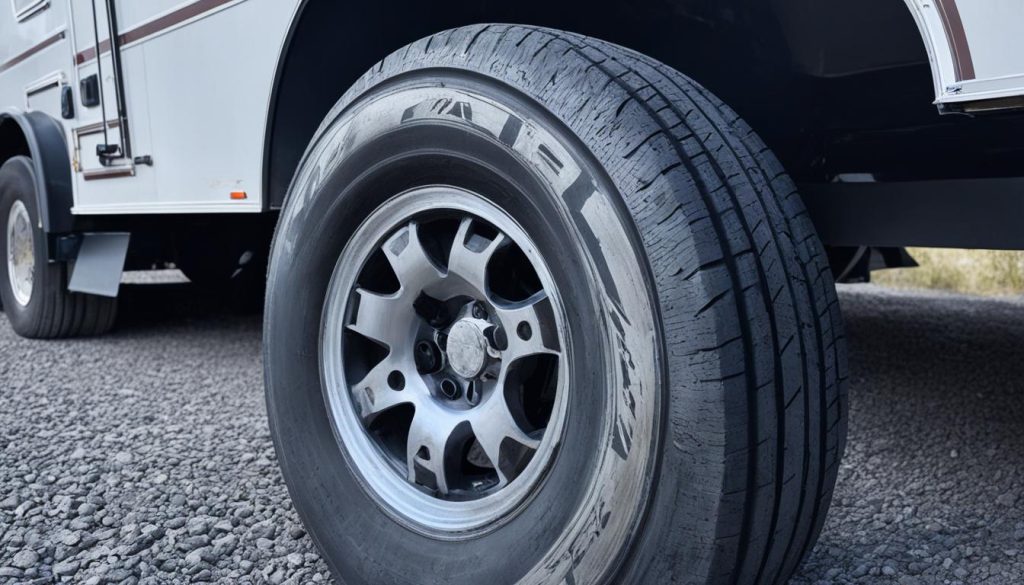
Maintenance Tips for Storing Your RV Tires
Properly maintaining and storing your RV tires during periods of non-use is essential for preserving their longevity and ensuring optimal performance. By following these tire storage best practices, you can avoid unnecessary wear and damage, and ensure that your tires are in excellent condition when you’re ready to hit the road again.
1. Visual Inspection
Before storing your RV, visually inspect your tires for any signs of wear, such as uneven tread wear or visible damage. Look out for cracks, bulges, or punctures that may require immediate attention or tire replacement. Repeat this inspection process when retrieving your RV from storage to ensure the tires are still in good condition.
2. Optimal Storage Conditions
Choosing the right storage location for your RV can make a significant difference in tire longevity. Store your RV in a cool, dry place away from direct sunlight to minimize exposure to harmful UV rays. Excessive heat and prolonged sun exposure can accelerate tire degradation. Consider using garage or covered storage facilities when available.
3. Surface Barriers
Using surface barriers, such as wooden boards or rubber mats, to separate your RV tires from direct contact with the ground can help prevent moisture absorption, which can lead to tire sidewall damage. This extra layer of protection can also minimize the risks of tire dry rot and deterioration.
4. RV Lifting
If feasible, consider lifting your RV off the ground using jacks or blocks to relieve the weight and pressure on your tires during storage. This method can help prevent tire flat spots and ensure even weight distribution, ultimately extending the life of your tires.
5. Tire Covers
Investing in high-quality RV tire covers is a wise decision for protecting your tires from sun exposure, ozone, and other environmental elements that contribute to premature aging and cracking. Make sure the covers fit securely and cover the entire tire surface, providing reliable protection for an extended period.
Proper maintenance and storage can significantly prolong the lifespan of your RV tires, ensuring your safety and optimal performance on the road.
By incorporating these maintenance tips into your RV tire storage routine, you can maintain the integrity and extend the lifespan of your tires. Remember to conduct regular inspections, opt for optimal storage conditions, use surface barriers, consider lifting your RV off the ground, and invest in quality tire covers. By prioritizing these maintenance practices, you’ll be ready to embark on your next adventure with confidence and peace of mind.
How to Survive an RV Tire Blowout
While it’s always best to prevent an RV tire blowout through regular maintenance and inspection, knowing how to handle a blowout can be crucial for your safety. No one wants to experience the sudden burst of a tire while on the road, but being prepared and knowing how to react can help minimize risks and potential damages.
In the event of a blowout, it’s important to stay calm and keep a firm grip on the steering wheel. The initial reaction may be to brake abruptly, but this can cause the RV to swerve and lose control. Instead, gradually slow down while maintaining a steady grip on the wheel. Avoid overcorrecting the steering, as this can lead to further instability.
Try to steer in the direction of the blown tire. This may feel counterintuitive, but it helps to maintain stability and prevents the RV from veering off course. Once you’ve safely stopped, assess the damage. Check for any visible signs of tire failure or damage to other components. Don’t attempt to change the tire yourself unless you have the necessary expertise. Instead, contact a professional for assistance and let them handle the situation safely.
Remember, your safety is paramount in a tire blowout situation. By staying calm, maintaining control, and seeking professional help, you can minimize the risks and ensure a safer outcome. Regular maintenance, including tire inspections and replacements when needed, is crucial to prevent blowouts and keep your RV journey smooth and worry-free.
FAQ
When should I replace my RV tires?
It’s important to replace your RV tires when you notice signs of wear such as excessive wear, cuts, bulges, or dry rot. Regular inspections are necessary to ensure your tires are in good condition.
How can I determine the age of my RV tires?
You can check the DOT number stamped on the sidewall of your tire. The DOT number includes the date of manufacture, which can help you determine the age of your tires.
What are the signs of worn RV tires?
Signs of worn RV tires include uneven tread wear, cracks in the sidewall, punctures that cannot be repaired, and loss of tread depth. These signs indicate the need for tire replacement.
What are the best practices for RV tire replacement?
It’s recommended to replace all of your RV tires at the same time for optimal performance and safety. Consider investing in high-quality tires suitable for your specific RV and travel needs. Regular tire maintenance, including inspections, inflation checks, and rotations, can also help extend the lifespan of your new tires.
How should I maintain and store my RV tires?
Properly store your RV tires by visually inspecting them before storage and again when taking them out. Store the RV in a cool and dry place away from direct sunlight, use surface barriers to separate the tires from the ground, lift the RV off the ground if possible, and cover the tires to reduce exposure to sunlight and ozone.
How should I handle an RV tire blowout?
In the event of a blowout, stay calm, grip the steering wheel firmly, and gradually slow down without abruptly braking. Avoid overcorrecting the steering and try to steer in the direction of the blown tire. Once you’ve safely stopped, assess the damage and contact a professional for assistance.

